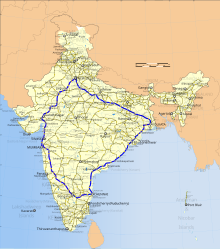Transport in India consists of transport by land, water and air. Road transport is the primary mode of transport for most Indian citizens, and India's road transport systems are among the most heavily used in the world.

India's road network is the second-largest, after the United States and one of the busiest in the world, transporting 8.225 billion passengers and over 980 million tonnes of cargo annually, as of 2015.[1] India's rail network is the fourth largest and second busiest in the world, transporting 8.09 billion passengers and 1.20 billion tonnes of freight annually, as of 2020.[update][2] Aviation in India is broadly divided into military and civil aviation which is the fastest-growing aviation market in the world (IATA data).[3] India's waterways network, in the form of rivers, canals, backwaters and creeks, is the ninth largest waterway network in the world. Freight transport by waterways is highly under utilised in India with the total cargo moved (in tonne kilometres) by inland waterways being 0.1 percent of the total inland traffic in India.[4] In total, about 21 percent of households have two wheelers whereas 4.70 percent of households in India have cars or vans as per the 2011 census of India.[5][6] The automobile industry in India is currently growing rapidly with an annual production of over 4.6 million vehicles,[7] with an annual growth rate of 10.5%[5] and vehicle volume is expected to rise greatly in the future.[8]
- ^ "India Transport Sector". World Bank. Archived from the original on 19 November 2015. Retrieved 10 February 2009.
- ^ "Statistical Summary - Indian Railways" (PDF). Indian Railways. Government of India. 2019–2020. Archived (PDF) from the original on 18 July 2021. Retrieved 2 April 2021.
- ^ "India crowned world's fastest growing aviation market in 2015 as economy takes off, The Telegraph, 1 January 2016". January 2016. Archived from the original on 10 January 2018. Retrieved 3 September 2019.
- ^ "Government groups 106 national waterways in three categories". The Economic Times. Archived from the original on 13 June 2018. Retrieved 9 May 2016.
- ^ a b "Motor Vehicle Writup – Statistical Year Book, India 2015" (PDF). Ministry of Statistics and Programme Implementation. 2015. p. 7. Archived from the original (PDF) on 13 November 2015. Retrieved 19 July 2016.
- ^ "Bicycle Ownership in India". Bike-eu.com. Archived from the original on 13 May 2009. Retrieved 5 April 2010.
- ^ "World Motor Vehicle Production by Country: 2008–2009". OICA. Archived from the original on 6 November 2013. Retrieved 6 May 2010.
- ^ Ramanathan, S. Kalyana. "India to top in car volumes by 2050". Rediff. Archived from the original on 25 December 2018. Retrieved 6 May 2010.